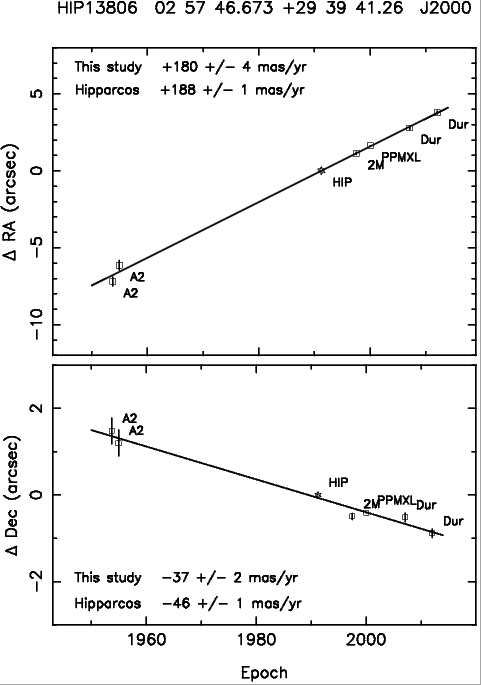Hyades Bridges
Distance to the Hyades Cluster
Introduction
An accurate distance to the nearby Hyades star cluster is of considerable importance for the extragalactic distance scale. The project will investigate the classic “convergent-point”-based methods. Using published and new data the reliability of the various convergent techniques will be assessed and a distance to the Hyades derived.The key aspects of the project will include:
- understanding the importance of the Hyades distance in the wider context,
- understanding what proper motions are and how they are measured,
- reviewing the “convergent-point” technique and various data sources,
- measuring the positions and hence proper motions of a set of Hyades stars observed with our 12-inch telescope (West-12) in January 2012,
- making an independent measurement of the Hyades distance by combining the measured proper motions with published radial velocity measurements,
- reviewing random and systematic uncertainties of the measurement,
- exploring ways to improve the experiment.
Background
The Hyades is an open cluster of a few 100 stars in the constellation of Taurus. The cluster members share a common space motion. As seen from the Earth, the paths of the stars converge towards a point in space. This geometry can be used to measure the distance to the cluster, i.e. the convergent point method. On average the Hyades stars have a proper motion of 0.12 arcsec yr-1 and a radial velocity of +40 km s-1. The main core of the cluster lies about 33° from the convergent point.

The plot above shows the sky distribution (in Right Ascension and Declination) of the Hyades. The core of the cluster is at about RA = 4h 24m and Dec = +15° and the convergent point is at about RA = 6h 08m and Dec = +7°. The arrows in the above plot show the motions of the Hyades stars over the next ~50,000 years.

If is the angle from the cluster centre to the convergent point, VR the average cluster radial velocity in km s-1 and ![]() the average proper motion in arcsec yr-1, then the cluster distance, d, in parsecs, is given by
the average proper motion in arcsec yr-1, then the cluster distance, d, in parsecs, is given by

Such measurements give a distance to the Hyades of about 46 parsec (150 light-years).
Project Notes
- Accurate stellar position measurements are made from CCD images which, when compared to earlier epoch measurements, yield proper motions. An ex-Level-One computer-based experiment focuses on The Motion of Barnard’s Star, which is a nearby red dwarf which has the largest known proper motion (10.3 arcsec yr-1). You should review this experiment first as an introduction to the measurement of proper motions.
- A good introduction to the convergent point method is the Distance to the Hyades Cluster (local copy) lab exercise from the University of Washington. It is recommended that you complete this exercise as a key element of the project.
- Recent work on measuring the distance to the Hyades have mainly focussed on data from the Hipparcos satellite. These include: Perryman et al. 1998, van Leeuwen 2009 and Roeser et al. 2011.
- ~39 Hyades stars were observed with Durham’s West-12 telescope on 2012 January 12. Each CCD image covers an area of 18′ × 13′ centred on the target star and includes several distant comparison stars. Co-add images are available for the astrometry measurements.
- To define positions of objects in the sky astronomers use a system similar to latitude and longitude, i.e. the RA-Dec system. RA is usually measured in units of hours, minutes, seconds of TIME whereas Dec is measured in the usual units of degrees, arcminutes, arcseconds. Note that one second of RA (a second of time) is a much larger unit than one second of Dec (an arcsecond). To convert a difference in RA in seconds (of time) to an RA difference in arcseconds:
RA difference [arcsecond] = RA difference [seconds of time] x 15 cos(Dec)
- In order to transform the (x,y) positions of stars on a CCD frame to (RA,Dec) coordinates a mapping is used.
- Hebert Raab’s superb Astrometrica programme will be used to measure the Hyades’ star positions on the CCD images. Mark and Rob’s guide to using Astrometrica contains much good advice as does their guide to the various settings. Programme defaults should be already set for the West-12 images.The recommended source of reference stars is the UCAC4 catalog. This is “a high density, highly accurate, astrometric catalog of over 113 million objects covering the entire sky. Proper motions and photometry are provided for all stars. Positions are on the ICRS (International Celestial Reference System) and given for the epoch J2000.0” and “The precision of the positions are 15-70 milli-arcsec, depending on magnitude, with estimated systematic errors of 10 milli-arcsec or below.” Note this is not a complete catalogue of all stars.
- Published measurements of stellar positions on the J2000 equinox system for Hyades stars can be obtained from VizieR. For example for the Hyades star, HIP13806, the following positions and epochs can be found,
Catalogue RA_J2000 Dec_J2000 Epoch
(degrees) (degrees) (year)
--------------------------------------------------
usno-a2 044.441645 +29.661984 1953.770
usno-a2 044.441984 +29.661906 1954.969
hipparcos 044.44394488 +29.66157319 1991.250
2mass 044.444311 +29.661436 1997.520
durham 2007 044.4448333 +29.661435 2007.100
durham 2012 044.4451541 +29.661327 2012.035 (RA_J2000, Dec_2000) is the measured position on the J2000 equinox system. The epoch is the date of the observation.
The diagram below illustrates the proper motion of the star HIP13806 using measurements from the literature and Durham. By fitting a linear regression to the data points the proper motion in milli-arcsec yr-1 can be determined. In the diagram the positions offset from the Hipparcos measurement are plotted.

